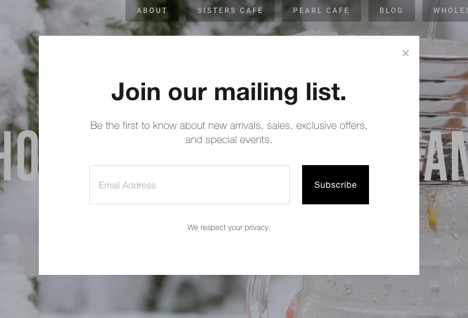Let’s see how you can get visitors’ emails and build a decent lead base.
-
Install a Sticky Top Bar
You’ve probably seen a lot of these while browsing websites, and the reason why they’re so popular is their non-obstructive nature and the ability to capture visitor emails. A sticky bar appears at the top of the screen (but can be made to be displayed at the sides, too) and stays there as the visitor browses a website’s pages.
For example, this bar at Content Marketing Institute’s website invites the visitor to register for an event.
Thanks to the “stickiness,” the bar remains within a visitor’s sight at all times and encourages them to leave an email in exchange for a newsletter, a free resource, or a free service.
-
Enable a Pop-up Window
Let’s get one thing straight right away: pop-up windows are obstructive by nature, so they get a bit of a bad rap for that. In fact, it’s a known fact that 95 percent of Internet users hate them, and 69 percent use pop-up blockers.
This is not to say that your website shouldn’t have one, but rather that you need to think about how to minimize the obstructive effect.
For example, there are two ways to implement pop-up windows to keep the customer experience at your website as positive as possible:
- At the end of blog posts. If a visitor scrolled down to the end of the blog post, chances are they’re interested in the content you’ve produced, so why not offer to provide them with more? That’s why you should have a pop-up window triggered when a visitor reaches 80 percent of the way down the page to ask if you can share more content with them
- A triggered window to prevent exits. This is perhaps the most commonly used kind of pop-up window that appears when a website visitor is about to leave the site.
An example of a pop-up window from Sisters Coffee below is good because it describes the benefits of subscribing to the newsletter.

Also, the company lets the viewer know that they won’t spam subscribers or give their emails to third parties by saying “We respect your privacy.” Well done.
Try to avoid having pop-up windows that appear almost immediately after someone lands on your website without any triggers. This is the worst kind that gives pop-ups a bad name and undermines the quality of user experience on your website.
-
Dedicated Lead Capture Forms
This is another great way to capture visitors’ emails because it’s more relevant than pop-up windows. Besides, you can also place lead capture forms on multiple pages in places where they could be relevant to the visitors. Added with an encouraging text, a dedicated lead capturing form could be a great addition to your visitor management effort by getting you more emails.
There are many ways to implement dedicated lead capture forms on a website. For example, The Law Professionals, a company providing legal services, collects such information from visitors as names, emails, phone numbers, and descriptions of their requests with this form.

In exchange for this information, they offer a free case evaluation, which is something that many of the visitors will appreciate.
Next, Portland Coffee Roasters have a simple email capture form at the bottom of its website. Take note of a great copy that encourages the readers to leave their details, it’s a great example of copywriting.

“A great thing about lead capture forms is that you can place them in different places on the website,” says Tom Rowe, a website localization expert at TheWordPoint. “However, when you decide which fields to include, be sure that you’re only asking for essential information and not something you don’t really need.”
In many cases, companies go too far and ask tons of questions in the lead forms, failing to understand that fewer people would be willing to spend a lot of time filling out 10+ fields. As a result, the conversion rate can go down if you do the same.
-
Live Chat
This is a popular way to connect with online businesses and get fast answers. For example, live chat is especially relevant for online marketplaces that need to provide customer support and product-related answers. Not only live chat is a preferred method to contact businesses by many customers, but it also plays a great role in building a base of leads and improving the conversion rate of eCommerce traffic.
You can either request customer email and other data as a mandatory requirement to start the chat or ask for them later in the conversation. For example, Just Answer, a legal services company, has a sizable live chat window at the home page to connect with the visitors and gather data.
In addition to collecting visitor data, you can also learn more about their typical needs, which can enable you to provide more personalized services and anticipate customer requests.
For example, Zendesk Chat allows monitoring visitor behavior – which pages on your website they visited, their locations, how they found you, and how many times they’ve visited so far – to help you understand them better.
Visitor Conversion is Critical
Traffic without conversions has little to value for an online business, so having a system in place to manage visitors is tremendously important. Thankfully, there is a range of techniques you can employ to achieve this goal, with some of the most effective ones listed above.
Just keep in mind to implement these techniques in a way that keeps user experience on your website positive and provides value. Your goal is to encourage them to convert, not force them to, so plan your conversion strategy accordingly.